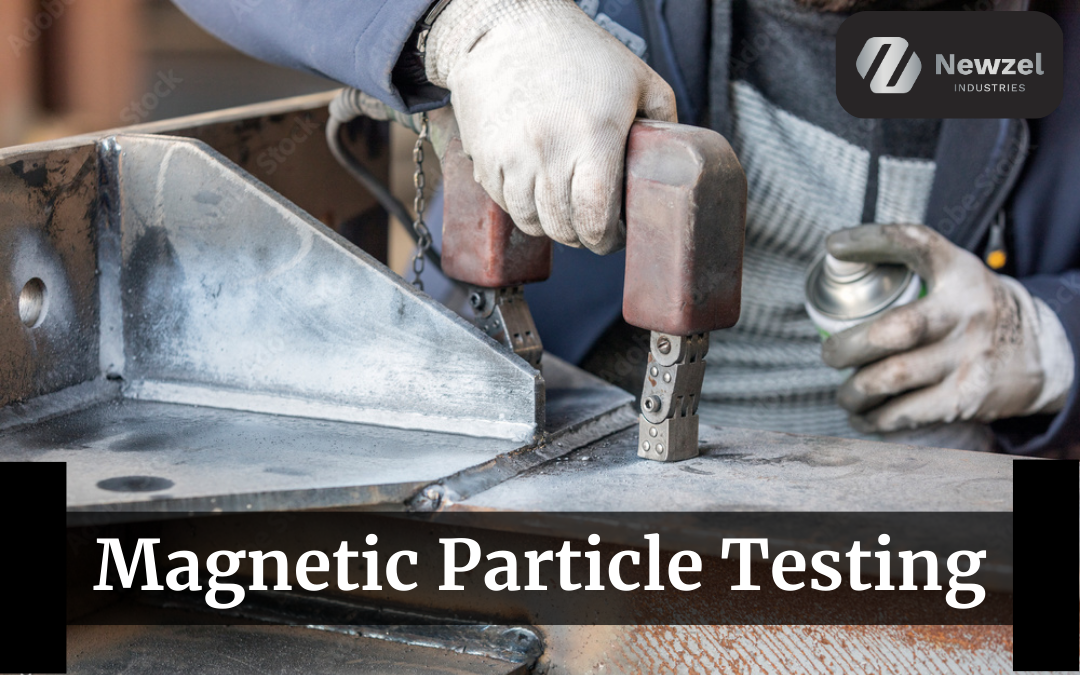What is Magnetic Particle Testing?
Magnetic Particle Testing, also called Magnetic Particle Inspection (MPI), is a method used to detect flaws in a component by magnetizing it to create lines of magnetic flux within it. When the magnetic flux lines encounter a defect that is oriented perpendicular to their direction, a magnetic leakage field is produced at or just above the surface of the component. This leakage field is made visible by applying finely divided ferromagnetic particles that are attracted and held by the leakage field. These magnetic particles are applied in the form of either dry powder or wet suspension, and they outline the defect, indicating its size, shape, location, and extent.
What are the Methods of Magnetisation?
There are two primary ways to generate a magnetic flux in the component being tested. The first involves introducing an external magnetic field into the component using a source such as an electro-magnet, a permanent magnet, or a current carrying conductor that is near or formed into a coil adjacent to the component. Alternatively, a direct electric current can be passed through the component, which induces a magnetic flux perpendicular to the direction of the current flow. The waveform of the current can vary from direct current (DC) to alternating current (AC), with AC being more sensitive to surface breaking discontinuities, while DC has the potential to detect slightly subsurface discontinuities.
Dry and Wet Magnetic Particles
In magnetic particle testing, the choice of particles plays a crucial role in detecting discontinuities within the tested component. To effectively indicate magnetic flux leakage fields, the particles used should possess high magnetic permeability. On the other hand, low retentivity is also essential to prevent the particles from attaching to the surface of the component or to each other. Typically, two types of magnetic particles are used in this process.
Dry Magnetic Particles –
This method involves using magnetic particles of different sizes to detect various sizes of flux leakage sites. Smaller particles are more sensitive to smaller defects or flaws, while larger particles can detect larger flux leakage sites.
Wet Magnetic Particles –
To detect flaws and defects, wet magnetic particles are used by suspending them in a liquid medium such as water or oil. This technique is more responsive to flux leakage sites than the dry magnetic particle method, as the particles are more mobile when they are in a suspended state. The use of this method also enables a larger surface area to be covered, leading to the detection of more flux leakage sites.
Magnetic Particle Testing Advantages and Disadvantages
Advantages of Magnetic Particle Testing Techniques:
Magnetic Particle Testing (MPT) offers several advantages as a non-destructive testing technique. Some of these advantages include:
- Highly sensitive: MPT is capable of detecting surface and near-surface flaws and defects that are difficult to detect by other non-destructive testing techniques.
- Cost-effective: MPT is a relatively low-cost inspection method compared to other non-destructive testing techniques, such as radiographic testing.
- Quick and efficient: The inspection process is relatively quick, and results are immediate, making it a suitable method for in-service inspections.
- Can be used on a variety of ferromagnetic components: MPT can be applied to a wide range of ferromagnetic materials, including castings, forgings, and weldments.
- Portable: The equipment used for MPT is lightweight and portable, making it suitable for on-site inspections.
- Non-hazardous: Unlike some other non-destructive testing techniques that use radiation, MPT is non-hazardous to operators and the environment.
Disadvantages of Magnetic Particle Testing:
Overall, the advantages of MPT make it a popular and widely used non-destructive testing technique in various industries.
- Limited to ferromagnetic materials: Magnetic particle testing can only be used on ferromagnetic materials. Non-magnetic materials cannot be inspected using this method.
- Surface sensitivity: The technique is surface-sensitive and can only detect surface or near-surface defects. Subsurface defects may not be detected by magnetic particle testing.
- Proper magnetisation is critical: Magnetic particle testing requires proper magnetisation of the test object. Improper magnetisation can result in missed defects or false indications.
- Only detects defects perpendicular to the magnetic field: Magnetic particle testing is only effective in detecting defects that are perpendicular to the magnetic field. Defects that are not oriented in this way may be missed.
- Limited application to complex geometries: The technique may be difficult to apply to complex geometries or areas with restricted access.
- Requires a clean surface: The surface of the test object must be clean and free of any contaminants that may interfere with the magnetic particle inspection.


